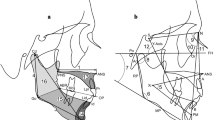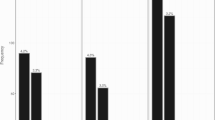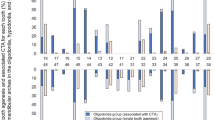Abstract
The purpose of this study was to investigate the patterns of bilateral agenesis of maxillary third molars and other tooth agenesis in Japanese orthodontic patients. A group of 262 subjects with bilateral agenesis of maxillary third molars (group A) was divided into three subgroups: group 1A consisting of 114 subjects without agenesis of mandibular third molars; group 2A, 31 subjects with unilateral agenesis of mandibular third molars; and group 3A, 117 subjects with agenesis of all third molars. As controls, 926 other subjects without third molar agenesis were selected (group C). Panoramic radiographs were mainly used to examine for tooth agenesis. The Chi square test and odds ratio were used to make statistical comparisons. The prevalence rates of agenesis of maxillary lateral incisors, mandibular incisors and maxillary and mandibular second premolars, and bilateral agenesis of maxillary lateral incisors and second premolars were significantly higher in any one of the third molar agenesis groups than in the control group. Characteristically, no significant increase in occurrence of bilateral agenesis of mandibular second premolars was demonstrated by the subjects with bilateral agenesis of maxillary third molars. Irrespective of whether unilateral or bilateral agenesis of mandibular third molars is present or not, the Japanese orthodontic patients with bilateral agenesis of maxillary third molars exhibited a significantly increased occurrence of unilateral or bilateral agenesis of maxillary lateral incisors, mandibular incisors and maxillary and mandibular second premolars, except for bilateral agenesis of mandibular incisors and second premolars.
Similar content being viewed by others
References
Grahnen H. Hypodontia in the permanent dentition. Odont Revy Suppl. 1956;7(Suppl 3):1–100.
Hellman M. Our third molar teeth; their eruption, presence and absence. Dent Cosmos. 1936;78:750–62.
Nanda RS. Agenesis of the third molar in man. Am J Orthod. 1954;40:698–706.
Thompson GW, Popovigh F, Anderson DL. Third molar agenesis in the Burlington Growth Centre in Toronto. Community Dent Oral Epidemiol. 1974;2:187–92.
Hattab FN, Rawashdeh MA, Fahmy MS. Impaction status of third molars in Jordanian students. Oral Surg Oral Med Oral Pathol Oral Radiol Endod. 1995;79:24–9.
Mok YY, Ho KK. Congenitally absent third molars in 12 to 16 year old Singaporean Chinese patients: a retrospective radiographic study. Ann Acad Med Singap. 1996;25:828–30.
Endo S, Sanpei S, Ishida R, Sanpei S, Abe R, Endo T. Association between third molar agenesis patterns and agenesis of other teeth in a Japanese orthodontic population. Odontology. 2015;103:89–96.
Levsque GY, Demirjian A, Tanguay R. Sexual dimorphism in the development, emergence, and agenesis of the mandibular third molar. J Dent Res. 1981;60:1735–41.
Sandhu S, Kaur T. Radiographic evaluation of the status of third molars in the Asian-Indian students. J Oral Maxillofac Surg. 2005;63:640–5.
Garib DG, Peck S, Gomes SC. Increased occurrence of dental anomalies associated with second-premolar agenesis Angle Orthod. 2009;79:436–41.
Garib DG, Alencar BM, Lauris JRP, Baccetti T. Agenesis of maxillary lateral incisors and associated dental anomalies. Am J Orthod Dentofac Orthop. 2010;137:732.e1–.e6.
Endo S, Sanpei S, Takakuwa A, Takahashi K, Endo T. Mandibular lateral incisor agenesis in a Japanese population and the occurrence of associated dental anomalies. J Dent Child. 2013;80:9–15.
Endo T, Sanpei S, Komatsuzaki A, Endo S, Takakuwa A, Oka K. Patterns of tooth agenesis in Japanese subjects with bilateral agenesis of mandibular second premolars. Odontology. 2012;101:216–21.
Garn SM, Lewis AB. The relationship between third molar agenesis and reduction in tooth number. Angle Orthod. 1962;32:14–8.
Celikoglu M, Bayram M, Nura M. Patterns of third-molar agenesis and associated dental anomalies in an orthodontic population. Am J Orthod Dentofac Orthop. 2011;140:856–60.
Faul F, Erdfelder E, Lang AL, Buchner A. G*Power 3: a flexible statistical power analysis program for the social, behavioral, and biomedical sciences. Behav Res Methods. 2007;39:175–91.
Massler M, Schour I, Poncher HG. Developmental pattern of the child as reflected in the calcification pattern of the teeth. Am J Dis Child. 1941;62:33–67.
Shinn DL. Congenitally missing third molars in a British population. J Dent. 1976;4:42–4.
Barka G, Tretiakov G, Theodosiou T, Ioannidou-Marathiotou I. Presence of third molars in orthodontic patients from northern Greece. Int J Gen Med. 2012;5:441–7.
Niswander JD, Sujaku C. Congenital anomalies of teeth in Japanese children. J Phys Anthropol. 1963;21:569–74.
Endo T, Ozoe R, Kubota M, Akiyama M, Shimooka S. A survey of hypodontia in Japanese orthodontic patients. Am J Orthod Dentofac Orthop. 2006;129:29–35.
Peres RC, Scarel-Caminaga RM, do Espirito Santo AR, Line SR. Association between PAX-9 promoter polymorphisms and hypodontia in humans. Arch Oral Biol 2005;50: 861–71.
Frazier-Bowers SA, Guo DC, Cavender A, Xue L, Evans B, King T, Milewicz D, D’Souza RN. A novel mutation in human PAX9 causes molar oligodontia. J Dent Res. 2002;81:129–33.
Acknowledgments
We thank Professor Akira Komatsuzaki, Department of Preventive and Community Dentistry, The Nippon Dental University School of Life Dentistry at Niigata, for help in the statistical analyses.
Conflict of interest
The authors declare that they have no conflict of interest.
Author information
Authors and Affiliations
Corresponding author
Rights and permissions
About this article
Cite this article
Sanpei, S., Ishida, R., Sanpei, S. et al. Patterns of bilateral agenesis of maxillary third molars and agenesis of other teeth. Odontology 104, 98–104 (2016). https://doi.org/10.1007/s10266-014-0185-y
Received:
Accepted:
Published:
Issue Date:
DOI: https://doi.org/10.1007/s10266-014-0185-y




